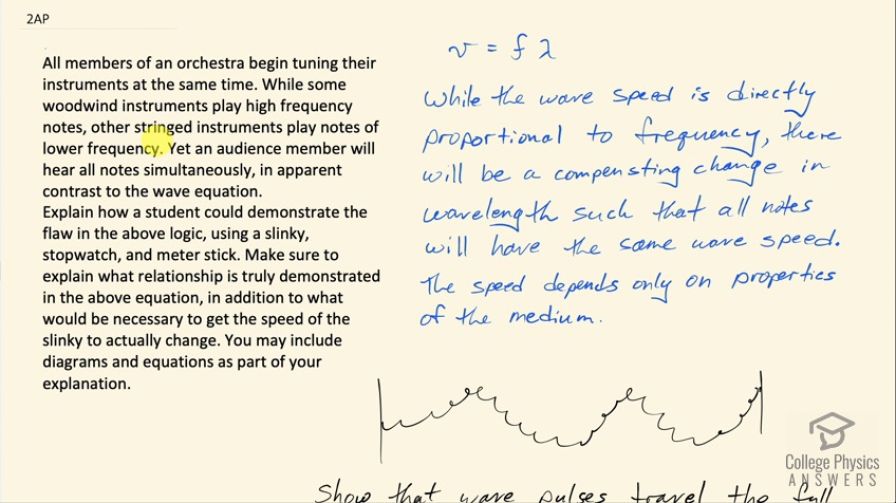Question
All members of an orchestra begin tuning their instruments at the same time. While some woodwind instruments play high frequency notes, other stringed instruments play notes of lower frequency. Yet an audience member will hear all notes simultaneously, in apparent contrast to the equation.
Explain how a student could demonstrate the flaw in the above logic, using a slinky, stopwatch, and meter stick. Make sure to explain what relationship is truly demonstrated in the above equation, in addition to what would be necessary to get the speed of the slinky to actually change. You may include diagrams and equations as part of your explanation.
Final Answer
Please see the solution video.
Solution video
OpenStax College Physics for AP® Courses, Chapter 17, Problem 2 (Test Prep for AP® Courses)

vote with a rating of
votes with an average rating of
.
Video Transcript
This is College Physics Answers with Shaun Dychko. This question is pointing out that in an orchestra, there are instruments playing high frequency notes and other instruments playing low frequency notes and yet somebody in the audience will hear the high and low notes at the same time; in other words, the notes are traveling all at the same speed so if the instrumentalist plays a high note and a different instrumentalist plays a low note at the same time, the person in the audience will hear both those notes at the same time and that would seem to contradict this wave equation because the speed of the wave is proportional to the frequency but while it's true that with a higher frequency you might expect a higher speed, there is nevertheless a compensating reduction in the wavelength when you have a higher frequency so in fact the product of these two is always the same. So for a high frequency, you are gonna get a low wavelength and then for a low frequency, you will get a higher wavelength such that when you multiply them, you will get the same speed. So the speed is dependent only on properties of the medium so the humidity, temperature of the air and you know, the mass density of the air those are the things that affect the speed, not the frequency. So this could be demonstrated with a slinky by using the stopwatch to time how long it takes for a pulse say this pulse to arrive at the other end of this slinky and then do that different multiple times for different frequencies so have this picture here on the one hand and then on the other hand make a pulse and then wait a long time before the next pulse and have a low frequency and show that these pulses will travel the full length of the slinky in the same time regardless of the frequency of them.